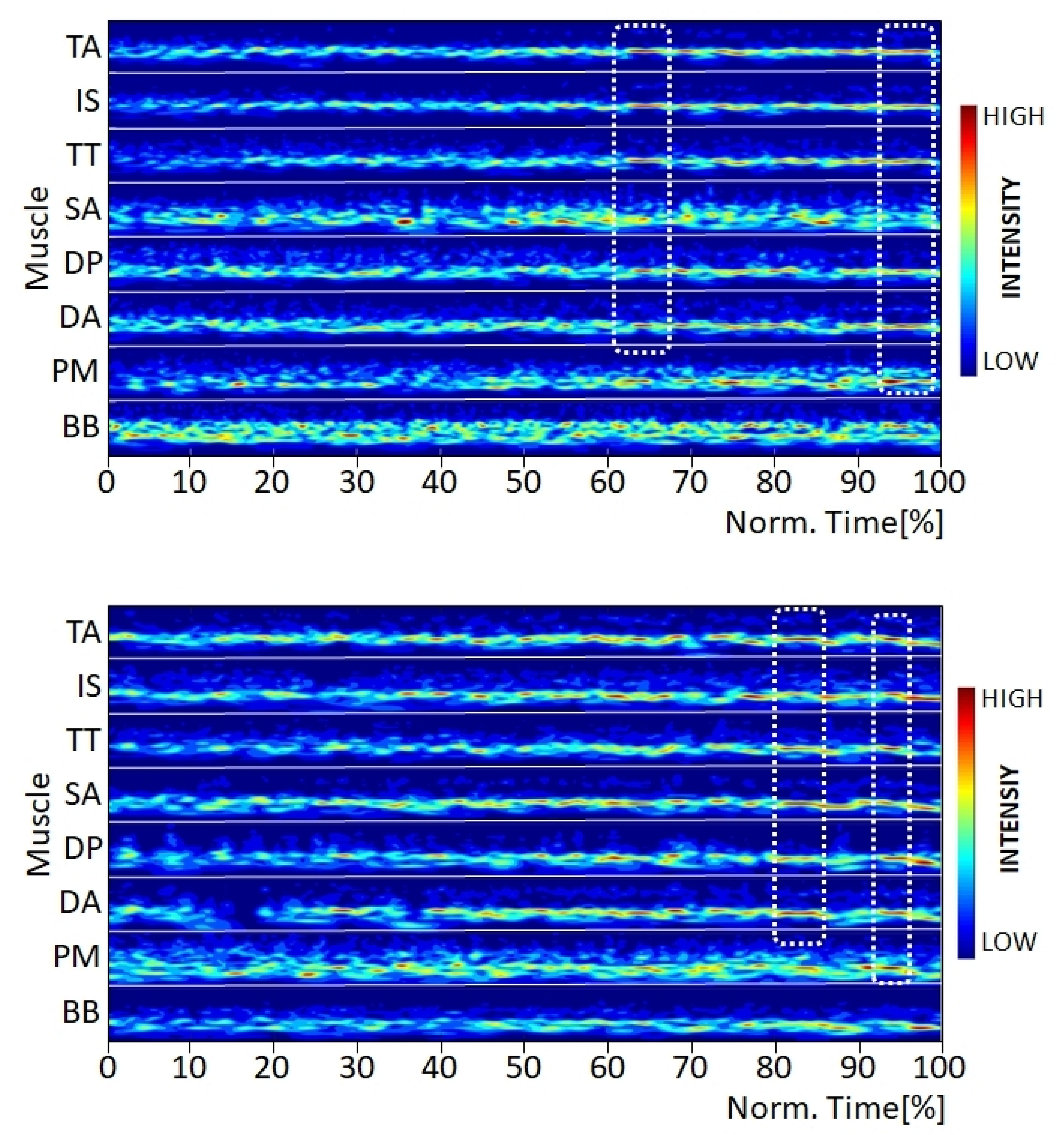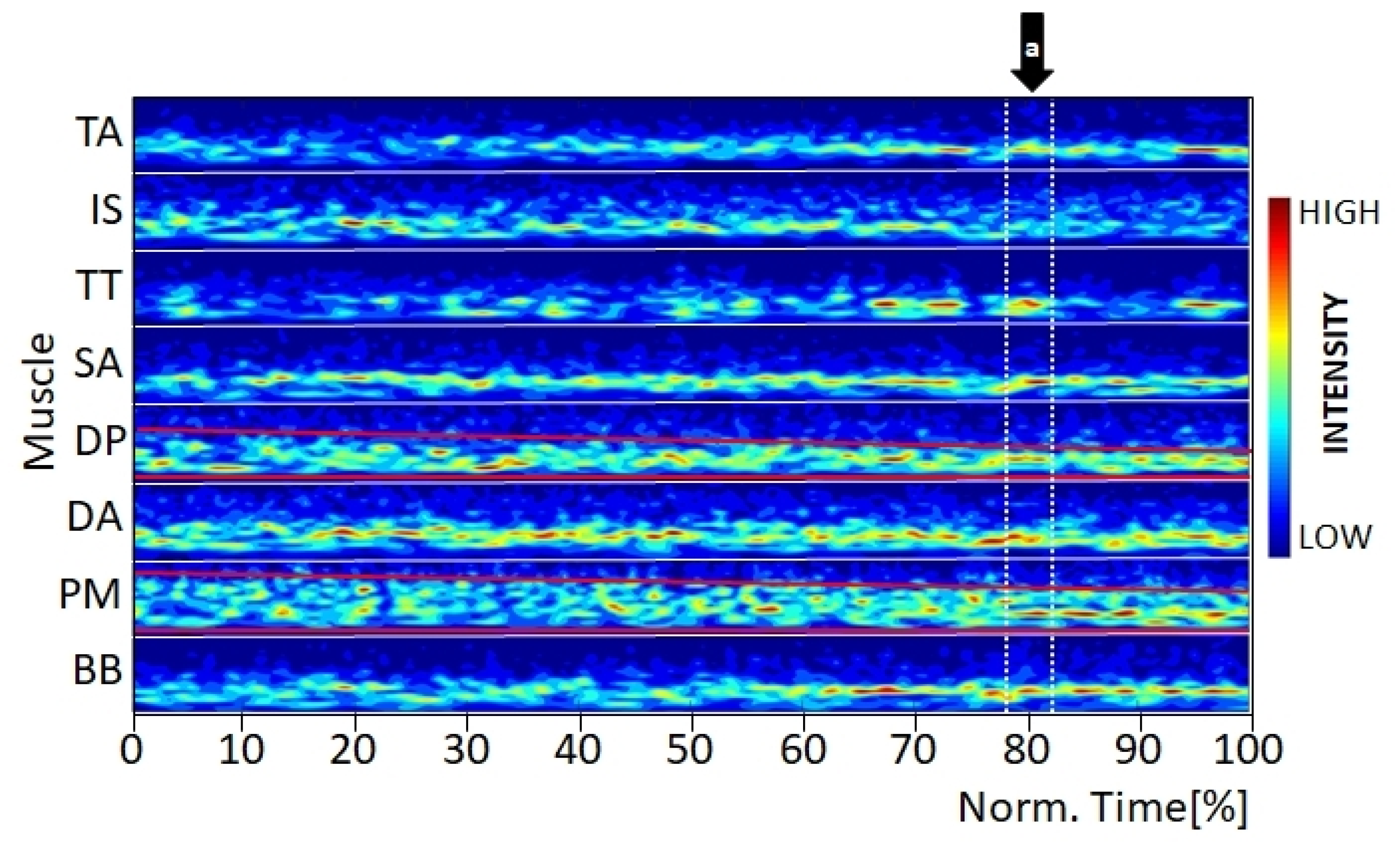Frequency Shifts in Muscle Activation during Static Strength Elements on the Rings before and after an Eccentric Training Intervention in Male Gymnasts
Abstract
:1. Introduction
2. Materials and Methods
2.1. Subjects
2.2. Data Collection and Processing
3. Results
3.1. Visual Inspection of MMIP
3.2. Correlations
4. Discussion
5. Conclusions
Author Contributions
Funding
Institutional Review Board Statement
Informed Consent Statement
Data Availability Statement
Conflicts of Interest
References
- Schärer, C.; Tacchelli, L.; Göpfert, B.; Gross, M.; Lüthy, F.; Taube, W.; Hübner, K. Specific eccentric–isokinetic cluster training improves static strength elements on rings for elite gymnasts. Int. J. Environ. Res. Public Health 2019, 16, 4571. [Google Scholar] [CrossRef] [PubMed] [Green Version]
- Shepstone, T.N.; Tang, J.E.; Dallaire, S.; Schuenke, M.D.; Staron, R.S.; Phillips, S.M. Short-term high-vs. low-velocity isokinetic lengthening training results in greater hypertrophy of the elbow flexors in young men. J. Appl. Physiol. 2005, 98, 1768–1776. [Google Scholar] [CrossRef] [PubMed]
- Beck, T.W.; Stock, M.S.; Defreitas, J.M. Shifts in EMG spectral power during fatiguing dynamic contractions. Muscle Nerve 2014, 50, 95–102. [Google Scholar] [CrossRef] [PubMed]
- Huber, C.; Göpfert, B.; Kugler, P.F.X.; Von Tscharner, V. The effect of sprint and endurance training on electromyogram signal analysis by wavelets. J. Strength Cond. Res. 2010, 24, 1527–1536. [Google Scholar] [CrossRef] [PubMed]
- Mohr, M.; Nann, M.; von Tscharner, V.; Eskofier, B.; Nigg, B.M. Task-dependent intermuscular motor unit synchronization between medial and lateral vastii muscles during dynamic and isometric squats. PLoS ONE 2015, 10, e0142048. [Google Scholar] [CrossRef] [PubMed]
- Wakeling, J.M. Motor units are recruited in a task-dependent fashion during locomotion. J. Exp. Biol. 2004, 207, 3883–3890. [Google Scholar] [CrossRef] [PubMed] [Green Version]
- Fidalgo-Herrera, A.; Miangolarra-Page, J.; Carratalá-Tejada, M. Traces of muscular fatigue in the rectus femoris identified with surface electromyography and wavelets on normal gait. Physiother. Theory Pract. 2020, 38, 211–225. [Google Scholar] [CrossRef] [PubMed]
- Hermens, H.J.; Freriks, B.; Disselhorst-Klug, C.; Rau, G. Development of recommendations for SEMG sensors and sensor placement procedures. J. Electromyogr. Kinesiol. 2000, 10, 361–374. [Google Scholar] [CrossRef]
- Shewman, T. Clinical SEMG Electrode Sites; Noraxon USA Inc.: Scottsdale, AZ, USA, 2018. [Google Scholar]
- FIG. Code of Points MAG, 2017–2020; FIG: Lausanne, Switzerland, 2017. [Google Scholar]
- Barandun, M.; von Tscharner, V.; Meuli-Simmen, C.; Bowen, V.; Valderrabano, V. Frequency and conduction velocity analysis of the abductor pollicis brevis muscle during early fatigue. J. Electromyogr. Kinesiol. 2009, 19, 65–74. [Google Scholar] [CrossRef] [PubMed]
- Clarys, J.P.; Scafoglieri, A.; Tresignie, J.; Reilly, T.; Van Roy, P. Critical appraisal and hazards of surface electromyography data acquisition in sport and exercise. Asian J. Sports Med. 2010, 1, 69. [Google Scholar]
- Bartuzi, P.; Roman-Liu, D. Assessment of muscle load and fatigue with the usage of frequency and time-frequency analysis of the EMG signal. Acta Bioeng. Biomech. 2014, 16, 31–39. [Google Scholar] [PubMed]
- Komi, P.V.; Tesch, P. EMG frequency spectrum, muscle structure, and fatigue during dynamic contractions in man. Eur. J. Appl. Physiol. Occup. Physiol. 1979, 42, 41–50. [Google Scholar] [CrossRef] [PubMed]
- von Tscharner, V.; Ullrich, M.; Mohr, M.; Marquez, D.C.; Nigg, B.M. A wavelet-based time frequency analysis of electromyograms to group steps of runners into clusters that contain similar muscle activation patterns. PLoS ONE 2018, 13, e0195125. [Google Scholar] [CrossRef] [PubMed] [Green Version]
- Stirling, L.M.; von Tscharner, V.; Kugler, P.; Nigg, B.M. Piper rhythm in the activation of the gastrocnemius medialis during running. J. Electromyogr. Kinesiol. 2011, 21, 178–183. [Google Scholar] [CrossRef] [PubMed]
- Huber, C.; Federolf, P.; Nüesch, C.; Cattin, P.C.; Friederich, N.F.; von Tscharner, V. Heel-strike in walking: Assessment of potential sources of intra-and inter-subject variability in the activation patterns of muscles stabilizing the knee joint. J. Biomech. 2013, 46, 1262–1268. [Google Scholar] [CrossRef] [PubMed] [Green Version]
- Piper, H. Über den willkürlichen Muskeltetanus. Arch. Gesamte Physiol. Menschen Tiere 1907, 119, 301–338. [Google Scholar] [CrossRef] [Green Version]
- Gabriel, D.A.; Kamen, G.; Frost, G. Neural adaptations to resistive exercise. Sports Med. 2006, 36, 133–149. [Google Scholar] [CrossRef] [PubMed]
- Tacchelli, L. Effet de Quatre Semaines D’entraînement de Force Excentrique-Isocinétique sur la Force Maximale et L’activité Musculaire lors des Éléments de Maintien en Force Aux Anneaux en Gymnastique Artistique Masculine; Université de Fribourg: Fribourg, Switzerland, 2018. [Google Scholar]




Publisher’s Note: MDPI stays neutral with regard to jurisdictional claims in published maps and institutional affiliations. |
© 2022 by the authors. Licensee MDPI, Basel, Switzerland. This article is an open access article distributed under the terms and conditions of the Creative Commons Attribution (CC BY) license (https://creativecommons.org/licenses/by/4.0/).
Share and Cite
Göpfert, B.; Schärer, C.; Tacchelli, L.; Gross, M.; Lüthy, F.; Hübner, K. Frequency Shifts in Muscle Activation during Static Strength Elements on the Rings before and after an Eccentric Training Intervention in Male Gymnasts. J. Funct. Morphol. Kinesiol. 2022, 7, 28. https://doi.org/10.3390/jfmk7010028
Göpfert B, Schärer C, Tacchelli L, Gross M, Lüthy F, Hübner K. Frequency Shifts in Muscle Activation during Static Strength Elements on the Rings before and after an Eccentric Training Intervention in Male Gymnasts. Journal of Functional Morphology and Kinesiology. 2022; 7(1):28. https://doi.org/10.3390/jfmk7010028
Chicago/Turabian StyleGöpfert, Beat, Christoph Schärer, Lisa Tacchelli, Micah Gross, Fabian Lüthy, and Klaus Hübner. 2022. "Frequency Shifts in Muscle Activation during Static Strength Elements on the Rings before and after an Eccentric Training Intervention in Male Gymnasts" Journal of Functional Morphology and Kinesiology 7, no. 1: 28. https://doi.org/10.3390/jfmk7010028
APA StyleGöpfert, B., Schärer, C., Tacchelli, L., Gross, M., Lüthy, F., & Hübner, K. (2022). Frequency Shifts in Muscle Activation during Static Strength Elements on the Rings before and after an Eccentric Training Intervention in Male Gymnasts. Journal of Functional Morphology and Kinesiology, 7(1), 28. https://doi.org/10.3390/jfmk7010028





